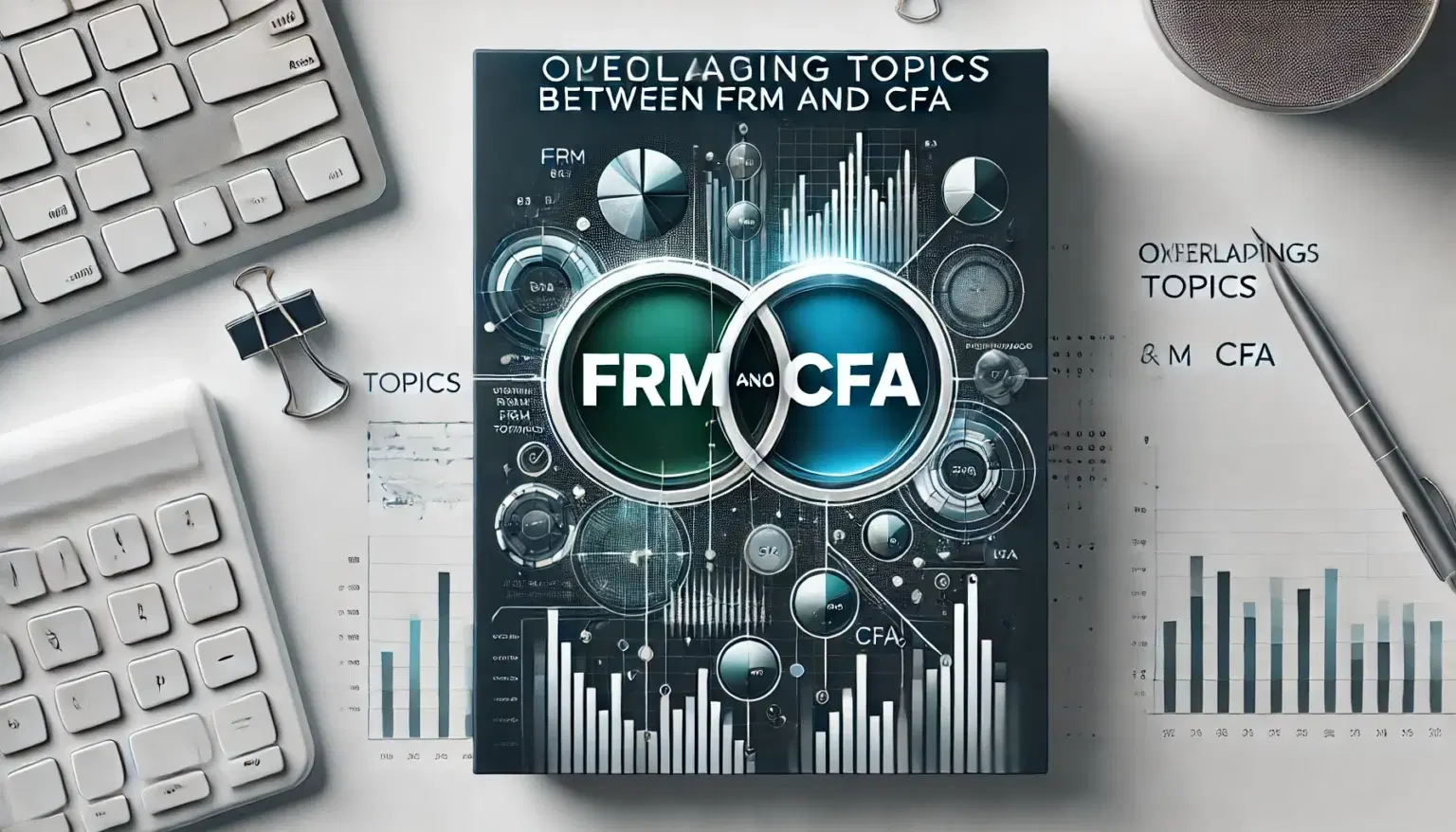Exam Preparation |
Finance Certifications
Overlapping Topics Between FRM and CFA

The Financial Risk Manager (FRM) and Chartered Financial Analyst (CFA) programs are two of the most prestigious designations in finance. Both designations, although catering to very different concentrations, have significantly overlapping material albeit somewhat differentially distributed through both respective curricula.
Understanding how these topics overlap can prove effective for candidates pursuing both designations. It not only optimizes study strategies but also enhances comprehension by reinforcing key concepts. Here’s a detailed breakdown of these overlaps and how they are distributed within the FRM and CFA programs:
1. Quantitative Methods (Major Overlap)
- FRM: The program heavily emphasizes quantitative methods in Part I, covering probability, basic and intermediate level statistics, along with introduction to modeling and machine learning techniques. These are foundational skills for understanding risk metrics and modeling.
- CFA: Quantitative methods form a substantial part of Level I, introducing statistical tools and techniques. These concepts are revisited in later levels as they are integral to portfolio management, financial modeling, and valuation.
Insight: Mastering quantitative methods early can be a game-changer, as these tools are the bedrock for analyzing data across both programs. CFA Level I provides a solid foundation, while FRM dives deeper into application, particularly for risk-specific scenarios.
2. Fixed Income (Major Overlap)
- FRM: Fixed income is a recurring theme across both parts, particularly in discussions around interest rate risk, credit risk, and market risk.
- CFA: Fixed income features prominently across all CFA levels, with a detailed focus in Level II. Topics include advanced valuation, yield curve strategies, and risk assessment techniques.
Insight: The CFA’s in-depth coverage of fixed income valuation methods complements the FRM’s focus on interest rate and credit risk. Candidates can approach fixed income in FRM with a valuation mindset honed during the CFA program.
3. Derivatives (Major Overlap)
- FRM: Derivatives are a major focus area in both parts, covering valuation techniques, pricing models, and their application in risk management.
- CFA: Introduced in Level I with basic concepts, derivatives are expanded in Levels II and III, addressing pricing, hedging strategies, and their role in portfolios.
Insight: The CFA program provides a structured progression, starting with fundamentals and leading to portfolio-level applications. FRM builds on these principles with a sharper focus on risk scenarios and advanced modeling.
4. Corporate Finance (Limited Overlap)
- FRM: Corporate finance is discussed in the context of credit risk, capital structure, and stress testing, primarily in Part II.
- CFA: This area is broader in scope within the CFA program, spanning Levels I and II with topics like capital budgeting, cost of capital, and financial strategy.
Insight: While corporate finance is not a primary focus in FRM, candidates should grasp its foundational concepts through the CFA program to appreciate its applications in risk management.
5. Portfolio Management and Risk Management (Minor Overlap)
- FRM: Portfolio management and risk measurement are core to both Part I and Part II. The curriculum delves into concepts like CAPM, Value-at-Risk (VaR), portfolio stress testing, and risk-adjusted returns.
- CFA: Portfolio management takes center stage in Level III, focusing on asset allocation and client-centric portfolio construction. Foundational ideas are introduced in Level I and expanded in Level II, linking theory with practical application.
Insight: Candidates preparing for both designations should pay special attention to risk-adjusted performance metrics and the practical implementation of portfolio theories. FRM’s emphasis on metrics like VaR complements CFA’s advanced portfolio construction strategies.
6. Ethics and Professional Standards (Very Limited Overlap)
- FRM: Ethics are embedded within the broader risk management framework and GARP’s Code of Conduct, but it comprises of only one short reading in FRM Part 1
- CFA: Ethics is a cornerstone of the CFA curriculum, rigorously tested across all three levels under the CFA Institute’s Code of Ethics and Standards of Professional Conduct.
Insight: While both programs stress ethics, the CFA’s approach is more comprehensive. FRM candidates pursuing CFA should use their existing knowledge as a foundation but expect deeper scrutiny in ethical dilemmas.
Strategic Benefits of Leveraging Overlaps
For FRM Candidates Pursuing CFA
- Start with CFA Level I to build a robust foundation in quantitative methods, economics, and ethics, which align with FRM Part I topics.
- As you progress to Levels II and III, focus on connections to FRM Part II topics like portfolio construction, derivatives, and credit risk.
For CFA Candidates Pursuing FRM
- Much of the foundational CFA material, especially in Levels I and II, overlaps with FRM Part I, allowing you to focus on risk-specific applications.
- FRM Part II’s advanced topics will complement the CFA Level III curriculum, particularly in portfolio management and risk-adjusted strategies.
Conclusion
The FRM and CFA programs, while distinct, offer significant synergies for finance professionals. By strategically leveraging the overlapping content, candidates can streamline their preparation, deepen their understanding, and enhance their expertise in finance and risk management. Whether your goal is to excel in investment analysis or specialize in risk, understanding these overlaps ensures that your efforts in one designation complement the other, maximizing both time and knowledge.
